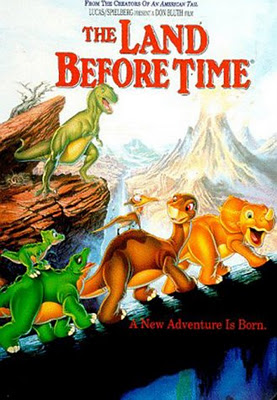And why wouldn’t it be? As much as I look for some reason to find my daughter’s favorite film objectionable, it’s one of the few kids’ movies that gets this feminist mama’s stamp of approval. The film’s subtle-but-present feminist message is evident from the animation alone. The protaganist Littlefoot, who is a male apatosaurus, is purple with long eyelashes, while his friend Cera the triceratops dons masculine features, a proud gait, and (both literally and physically) thick skin.
Although Cera is unfriendly something of a bully, I find myself viewing her as strong female character for this very reason. She has her flaws, but weakness and vanity are not among them. Nowhere in the film does this tough, fiercely indepentent reptile worry about her appearance or the pursuit of romance. Cera’s excessive independence and hubris do land her in trouble– just as the same features have harmed Lightning McQueen, Simba, and other male protagonists. Yet, while she eventually understands the importance of accepting others and working together, she never loses her admirable and independent spunk.
Although, like many films, this 1988 classic has a male protaganist, Littlefoot defies stereotypes of masculinity. He is sensitive, crying at several points in the film, and plays an almost maternal-role to the younger, less experienced members of the gang. Petrie the pteranodon and Spike the stegosaurus also defy all stereotypes associated with male heroes– Petrie is awkward and not particularly bright; Spike is cumbersome and strangely mute.
The anti-racist tones of this film are fairly subtle, but clear enough for children to pick up on. My daughter was quick to observe that “Sometimes grown-ups are wrong,” and that Cera’s domineering father is wrong for teaching his child to only socialize with other “three-horns.” Tolerance for diversity– in appearance, personality, philosophy and ability– are positively central to the story’s message.
Although I feel hesitant to give my feminist stamp of approval to a film that characteristically employs martyrdom, I didn’t find anything about Littlefoot’s mother’s character sexist. Littlefoot is born to a dwindling herd comprised of his mother, grandfather and grandmother. No ado is made about the fact that he has no father, and his mother is clearly a competent caregiver. Unlike Bambi’s mother, who dies running, Littlefoot’s mom puts up a brave and ferocious fight, hurling the predator into a chasm. She dies not of weakness, but of bravery– in a display of “Don’t mess with my kid!” that is universally parental– and not grounded in patriarchal stereotypes.
Littlefoot’s mother comes back, as a ghost or a grief-induced hallucination, at two other points in the film to guide Littlefoot to the Great Valley, a promised-land free of predators and overflowing with food and water. It is here that the next several films of the series are set. Interestingly, the happily-ever-after doesn’t involve a descent into a patriarchal nuclear family structure. Within the almost-socialist structure of the Great Valley, Cera goes on to be raised by her single dad, Spike is adopted into a biologically unrelated parasaurolophus family, Petrie returns to his single mom, and Littlefoot is raised by his grandparents. No family is presented as any more or less ideal than any other.
That’s why this movie, which was such a staple to me in my own childhood, remains on my A-OK list of feminist-friendly kids’ movies. And, just as importantly, my dinosaur-loving, patriarchy-smashing kiddo finds the film both entertaining and educational.
—–


